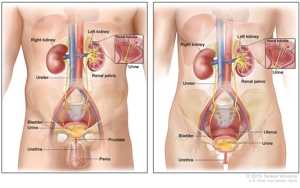Bladder Cancer

Anatomy of the male urinary system (left panel) and female urinary system (right panel); two-panel drawing showing the right and left kidneys, the ureters, the bladder filled with urine, and the urethra. The inside of the left kidney shows the renal pelvis. An inset shows the renal tubules and urine. Also shown are the prostate and penis (left panel) and the uterus (right panel). Click to see a larger diagram.
© 2010 Terese Winslow LLC, U.S. Govt. has certain rights. Used with Permission. Contact artist at www.teresewinslow.com for licensing.
Cancer is a disease in which cells in the body grow out of control. When cancer starts in the bladder, it is called bladder cancer. Each year in the United States, about 55,000 men and 17,000 women get bladder cancer, and about 11,000 men and 5,000 women die from the disease.
To lower the risk of bladder cancer, don’t smoke and be especially careful around certain kinds of chemicals.
What Is the Bladder?
The bladder (sometimes called the urinary bladder) is a balloon-shaped organ in your lower abdomen, near the pelvis. It stores urine from the kidneys until it is passed out of the body.
What Causes Bladder Cancer?
Smoking is the most important risk factor for bladder cancer. Other risk factors include—
- Having a family history of bladder cancer.
- Having certain gene mutations (unusual changes made when your body’s cells are dividing).
- Being exposed to too much of certain workplace chemicals [PDF-4.7MB] used in processing paint, dye, metal, and petroleum products.
- Taking some kinds of chemotherapy drugs.
- Drinking well water contaminated with arsenic.
- Taking the Chinese herb Aristolochia fangchi.
- Having chronic urinary tract infections (including those caused by Schistosoma haematobium).
What Are the Symptoms of Bladder Cancer?
- Blood in the urine. This is the most common symptom.
- Having to urinate often.
- Pain while urinating.
- Back pain.
- Pelvic pain.
These symptoms can also come from other conditions. If you have any of them, talk to your doctor, which is the only way to find out what may be causing them.
How Can I Reduce My Risk for Bladder Cancer?
To lower the risk of bladder cancer, don’t smoke (and if you do, quit) and be especially careful around certain kinds of chemicals.
Statistics
In the United States in 2014 (the most recent year for which numbers are available)—
- 72,462 people (55,014 men and 17,448 women) got bladder cancer.
- 15,775 people (11,291 men and 4,484 women) died from bladder cancer.
- Men were about three times as likely as women to get bladder cancer, and white people had higher rates of bladder cancer than people of other races and ethnicities.
- Among men, white men had the highest rates of getting bladder cancer (36.4 per 100,000 men), followed by black men (19.0), Hispanic† men (18.6), American Indian/Alaska Native men (14.8), and Asian/Pacific Islander men (14.0).
- Among women, white women had the highest rates of getting bladder cancer (9.0 per 100,000 women), followed by black women (6.4), Hispanic† women (4.8), Asian/Pacific Islander women (3.7), and American Indian/Alaska Native women (3.4).
†Hispanic origin is not mutually exclusive from race categories (white, black, Asian/Pacific Islander, American Indian/Alaska Native).
Data source: U.S. Cancer Statistics Working Group. United States Cancer Statistics: 1999–2014 Incidence and Mortality Web-based Report. Atlanta (GA): Department of Health and Human Services, Centers for Disease Control and Prevention, and National Cancer Institute; 2017. Available at: http://www.cdc.gov/uscs.
More Information
- Bladder Cancer (National Cancer Institute)
- Smoking and Tobacco Use: Cancer (Centers for Disease Control and Prevention)
- Chemicals, Cancer, and You [PDF-4.7MB] (Agency for Toxic Substances and Disease Registry)
- Cancer-Causing Substances in the Environment (National Cancer Institute)
- Page last reviewed: June 6, 2017
- Page last updated: June 6, 2017
- Content source:


 ShareCompartir
ShareCompartir